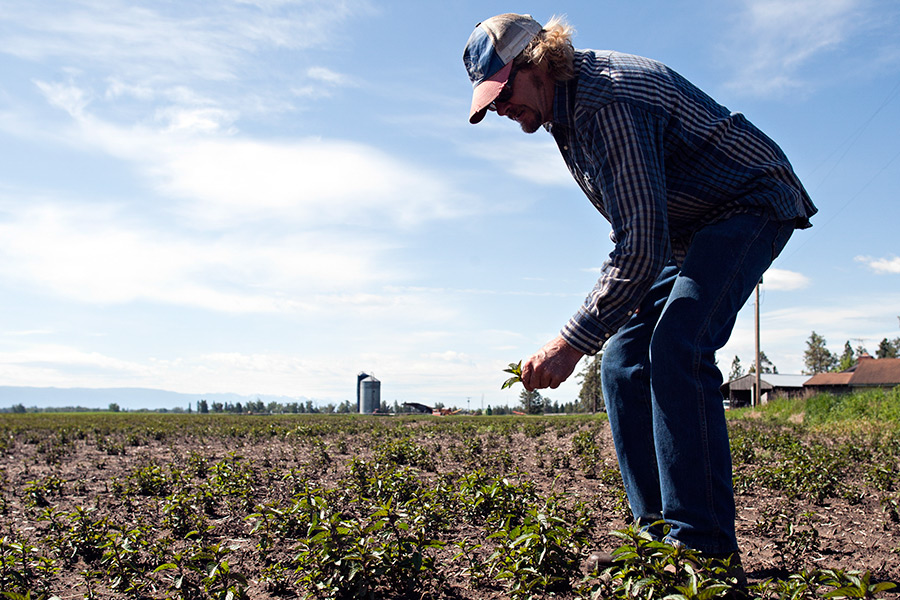CRESTON – Kirk Passmore stands in his farmland, looking at the green mint plants sprouting from the fertile Flathead Valley soil. Not far off, his farm dogs are foraging for whatever it is farm dogs like to roll in, panting and happy in the sunshine.
It’s peaceful here on the last mint farm in the Flathead Valley. The skies are finally blue after the prior week’s deluge of several inches of rain, and the view into the Glacier National Park’s west border frames the fields.
The spearmint field next to the Passmore’s farmhouse is well on its way to being a hardy yield come mid-August. The mint smell is impossible to miss, and plucking a deep green leaf releases a refreshing spearmint flavor.
Peppermint plants are just starting to come into their own in a nearby field. Passmore stands in the dirt and wonders aloud why he’s kept going in the mint growing business, when everyone else in the state has given it up.
Diversifying his crops is one reason, he says, and mint oil still brings in a pretty penny on the market. And his family has been growing the mint plants for decades.
“It’s fun to watch it grow and it’s fun to smell,” he says.
There used to be dozens of mint farmers in the Flathead Valley, but commodity pricing and the influence of global producers made it a tough crop to justify growing.
In the end, it came down to the bottom line for many farmers.
“You have to make money at it,” said state Department of Agriculture Director Ron de Yong. “It has got to be a break-even situation. It’s not an easy crop to raise.”
De Yong grew peppermint in the Flathead for years, and was one of Passmore’s neighbors back in his growing days.
“It was really a nice product to raise at that time,” he said. “It was really kind of pleasant.”
Mint producers in the Flathead sold their mint oil – made in stills on local farms – to four big brokers at that time, de Yong said. The oil would then be sold to various companies throughout the nation, and used for toothpaste, candy, menthol, gum, and more.
But the plant is labor intensive, and often needs to be weeded by hand and sprayed for weeds multiple times.
Clyde Fisher, who used to run C & J Mint Farm in Columbia Falls, said he gave up on growing mint three years ago after harvesting it for more than 30 years.
“We quit,” Fisher said. “Didn’t pay you enough to raise it.”
Fisher was on the now-defunct Montana Mint Committee through the Department of Agriculture, along with Passmore and local farmer Ken Smith. Passmore is the final holdout.
“Kirk is a good producer; he’s actually able to do it very reasonably,” de Yong said. “He’s very good on the bottom line.”
It’s tough to mimic mint flavor through chemicals, Passmore said, and many consumers still want commodities that use the natural oils.
Of the 700 acres that the Passmores’ farm, about 30 are dedicated to native spearmint plants, which are resistant to wilt, and another 100 acres are for the more-delicate-but-higher-valued peppermint plants.
The Passmores installed new still equipment to extract the oil from their mint plants when the market was high, and that equipment pumps out enough oil to fill many 55-gallon drums.
Each pound of peppermint oil is worth between $21 and $23, and spearmint runs at about $18 to $20 per pound. Passmore will pull about 50 pounds of oil per acre of peppermint and about 80 pounds of oil per acre of spearmint.
“You can put more dollars into the back of a pickup truck than the pickup’s worth when you’re moving mint oil,” Passmore said.
Still, despite it being a relatively lucrative product, the amount of time and energy that goes into it tends to counter any profit, he said, and major producers in India and China have flooded the market.
That oil isn’t as high quality, both Passmore and de Yong said, and is usually mixed with stronger, natural peppermint or spearmint oil before it is used.
There’s also the competition west of the Flathead, in Washington state where it’s wet enough that farmers can get two harvests of their mint fields in a season.
Passmore is used to selling his mint oil in 55-gallon drums, but he has sold five-gallon and 15-gallon amounts to Montana candy and chew makers. He hasn’t really pursued the value-added market, because it’s more of a hassle than he’s used to.
Plus, he’s got fields of canola and winter wheat to balance out any dips in the mint market, and vice-a-versa.
The future of Passmore mint isn’t clear, he said, but he doesn’t intend to quit any time soon. It’s just part of the farm, and they’re still getting by selling a product no one else here grows.
“And it is kind of fun to be the last game,” Passmore said.
UPDATE: This story has been changed to reflect information that there is another mint farm in Montana, Stonebrook Farm, located in Plains.
